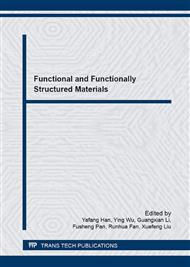[1]
K. Yuan, F. Wang, J. Gao, X. Sun, Z.X. Deng, H. Wang, L. Jin, J.H. Chen. Effect of zircon-based tricolor pigments on the color, microstructure, flexural strength and translucency of a novel dental lithium disilicate glass-ceramic. J. Biomed. Mater. Res. B. Appl. Biomater. 102 (2014).
DOI: 10.1002/jbm.b.32986
Google Scholar
[2]
Z.Y. Yao, J.H. Qi, L.H. Wang. Isolation, fractionation and characterization of melanin-like pigments from chestnut (castanea mollissima) shells. J. Food. Sci. 77 (2012) C671–76.
DOI: 10.1111/j.1750-3841.2012.02714.x
Google Scholar
[3]
M. Jansen, H.P. Letschert. Inorganic yellow-red pigments without toxic metals. Nature 404 (2000) 980–982.
DOI: 10.1038/35010082
Google Scholar
[4]
C. Peng, C.X. Zhang, M. Lv, J.Q. Wu. Preparation of silica encapsulated carbon black with high thermal stability. Ceram. Int. 39 (2013) 7247–7253.
DOI: 10.1016/j.ceramint.2013.01.078
Google Scholar
[5]
Y.F. Gao, F. Zhao, Y. Liu, H.J. Luo. Synthesis and characterization of ZrO2 capsules and crystalline ZrO2 thin layers on Fe2O3 powders. Cryst. Eng. Comm. 13 (2011) 3511–3514.
DOI: 10.1039/c0ce00989j
Google Scholar
[6]
Q.B. Chang, X. Wang, Y.Q. Wang, Q.F. Bao, J.E. Zhou, Q.X. Zhu. Encapsulated carbon black prepared by sol-gel-spraying: a new black ceramic pigment. J. Eur. Ceram. Soc. 34 (2014) 3151–3157.
DOI: 10.1016/j.jeurceramsoc.2014.03.020
Google Scholar
[7]
M. Cannio, F. Bondioli. Mechanical activation of raw materials in the synthesis of Fe2O3-ZrSiO4 inclusion pigment. J. Eur. Ceram. Soc. 32 (2012) 643–647.
DOI: 10.1016/j.jeurceramsoc.2011.10.008
Google Scholar
[8]
F. Andreola, L. Barbieri, F. Bondioli. Agricultural waste in the synthesis of coral ceramic pigment. Dyes. Pigm. 94 (2012) 207–211.
DOI: 10.1016/j.dyepig.2012.01.007
Google Scholar
[9]
W.H. Jiang, X.Y. Xu, T. Chen, J.M. Liu, X.J. Zhang. Preparation and chromatic properties of C@ZrSiO4 inclusion pigment via non-hydrolytic sol-gel method. Dyes. Pigm. 114 (2015) 55–59.
DOI: 10.1016/j.dyepig.2014.10.017
Google Scholar
[10]
X.D. Xu, M. Zhang, J. Feng, M.L. Zhang. Shape-controlled synthesis of single-crystalline cupric oxide by microwave heating using an ionic liquid. Mater. Lett. 62 (2008) 2787–2790.
DOI: 10.1016/j.matlet.2008.01.046
Google Scholar
[11]
L.J. Zhu, Y.T. Zheng, T.Y. Hao, X.X. Shi, Y.T. Chen, J.O. Yang. Synthesis of hierarchical ZnO nanobelts via Zn(OH)F intermediate using ionic liquid-assistant microwave irradiation method. Mater. Lett. 63 (2009) 2405–2408.
DOI: 10.1016/j.matlet.2009.07.062
Google Scholar
[12]
T.T. Li, S.L. Luo, L.X. Yang. Three-dimensional hierarchical Ag/AgI/BiOI microspheres with high visible-light photocatalytic activity. Mater. Lett. 109(2013)247–252.
DOI: 10.1016/j.matlet.2013.07.044
Google Scholar
[13]
N. Jia, S.M. Li, M.G. Ma, R.C. Sun. Microwave-assisted ionic liquid preparation and characterization of cellulose/calcium silicate nanocomposites in ethylene glycol. Mater. Lett. 65 (2011) 918–921.
DOI: 10.1016/j.matlet.2010.12.033
Google Scholar
[14]
M. Zhang, X.D. Xu, M.L. Zhang. Hydrothermal synthesis of sheaf-like CuO via ionic liquids. Mater. Lett. 62 (2008) 385–388.
DOI: 10.1016/j.matlet.2007.05.046
Google Scholar
[15]
S. Kongwudthiti, P. Praserthdam, W. Tanakulrungsank, M. Inoue. The influence of Si–O–Zr bonds on the crystal-growth inhibition of zirconia prepared by the glycothermal method. J. Mater. Process. Technol. 136 (2003) 186–189.
DOI: 10.1016/s0924-0136(03)00157-2
Google Scholar
[16]
X.D. Xu, M. Zhang, J. Feng, M.L. Zhang. Shape-controlled synthesis of single-crystalline cupric oxide by microwave heating using an ionic liquid. Mater. Lett. 62 (2008) 2787–2790.
DOI: 10.1016/j.matlet.2008.01.046
Google Scholar
[17]
J.A. Badenes, J.B. Vicent, M. Llusar, M.A. Tena, G. Monrós. The nature of Pr-ZrSiO4 yellow ceramic pigment. J. Mater. Sci. 37 (2002) 1413–1420.
Google Scholar


